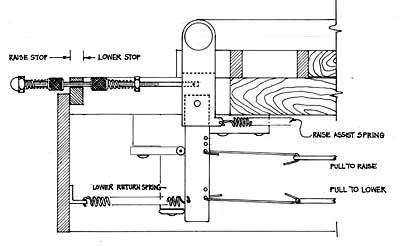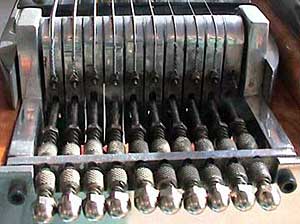
 |
|---|
These guitars were made from about 1965 until the early 70's when they were replaced by the "rack and barrel" system. They are, in my opinion, some of the most beautiful cabinets Sho-Bud ever produced-- just look at Lloyd Green's guitar on the cover of "Cool Steel Man" or "Mr. Nashville Sound."
They are called "fingertip" because you used your fingertip to tune the stops.
The pulling finger was slotted to take a length of threaded rod that was pinned in place. This rod passed though a plate that was fastened to the end casting. On each side of this plate was a knurled nut. This nut rode against a spring that was held by a regular hex nut on the inside, and an acorn nut on the outside.
When the string raised, the outside knurled nut was adjusted to stop against the outside of the plate to give the raise tone. When the string lowered, the inside nut was adjusted to hit the plate on the inside. The springs were in place to keep the tension on the nuts and to keep them from rolling of their own accord.
 |
|---|
 |
|---|
There were two sets of springs underneath: the spring which pulled the finger back to center from a lower, and a spring, attached to the pulling finger itself, which assisted in helping the raise.
The pull rods were hooked to the changer by a bent "hook" (similar to the Emmons). There were two holes in the bell crank. The rod passed through the hole and was activated by a set-collar attached to the pull rod. A spring was used (as in the Emmons) to allow two different strings to bottom at the same time. Any second stops (like the E-F on an E9th tuning) had to be adjusted underneath.